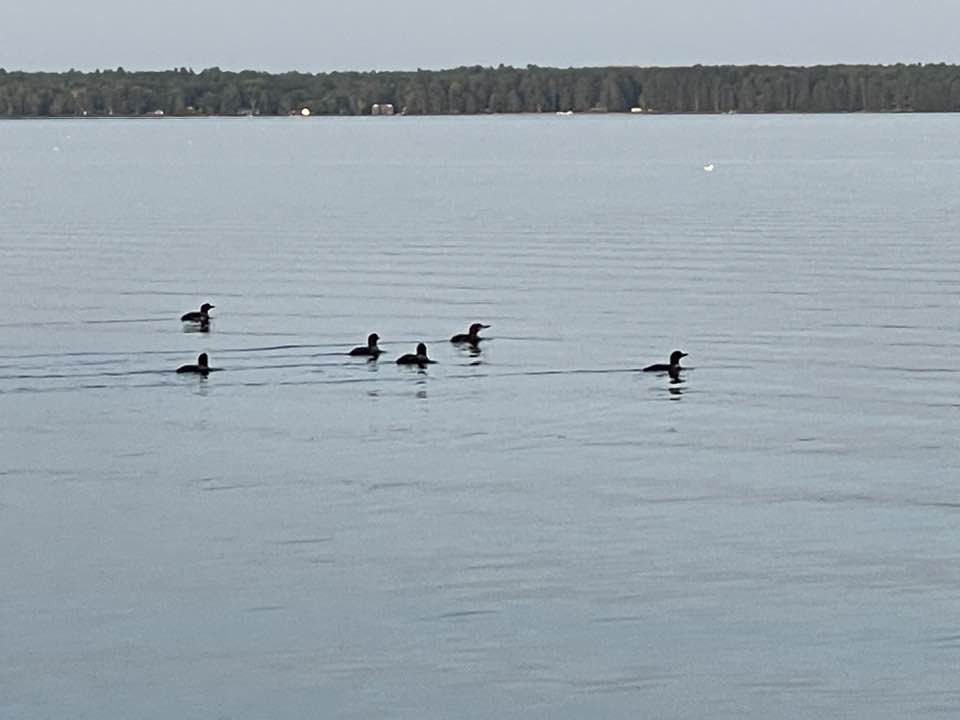SEPTEMBER 11, 2024 – Not that I’m superstitious or anything, but long ago I decided it was good luck if we saw at least one eagle during a stay at the Red Cabin on Grindstone Lake. The longer the stay, of course, the greater the odds of securing a measure of good luck. Early this morning when I walked out on the dock to see if I could catch a glimpse of the sun as it ascended above the horizon around the bend in the shoreline, what should I see but one, two, then three eagles flying east to west past the dock. They were no more than 20 feet off the water and 50 feet out from the end of the dock. Few royal processions could match the majesty of these magnificent creatures in search of breakfast.
The bald eagle is an environmental success story. Until 1971 when I saw my first eagle on Grindstone Lake, neither my parents nor grandparents nor anyone else I knew had ever seen a bald eagle here. The bird was in danger of extinction because of the widespread presence of DDT in the food chain. A side effect of the popular pesticide was that it weakened the shells of bald eagle eggs. Most eagle eggs didn’t hatch. It was just a matter of time before bald eagles would die out.
After reaching a peak application of 80 million pounds (U.S.), use declined to 13 million pounds by 1971, after Federal restrictions were initially imposed in 1969. On June 14, 1972, William D. Ruckelshaus, Richard Nixon’s appointee to head the newly established (1970) Environmental Protection Agency, signed an order canceling all remaining Federal registrations of DDT products.
The ban saved the eagle, which now is a thriving species.
Today’s sighting of three bald eagles flying in formation was not unusual. Throughout the summer we’ve seen multiple eagles perched in the same or adjacent trees and flying above the shoreline. Yet as commonplace as they might be, no one who observes an eagle is blasé about it.
Same goes for the loon. Generally, the loon’s habitat is under stress across the bird’s range, but on Grindstone (and neighboring lakes where they no doubt nest) the gavia immer or common loon is, well, quite common. Yet, their haunting tremolo, their laugh signaling danger, invariable draws comment. “Hear the loon?” or “There’s a loon,” my wife and I say to each other whenever we hear this beautiful waterfowl—or when we see one while we’re cruising on the pontoon. On Monday evening we saw three pairs of loons swimming and fishing together on the lake. Last summer while on a loon and eagle safari on Grindstone with our friends Steve and Nancy on their pontoon, we saw a group of no fewer than nine pairs of loons. To our surprise, the fleet was swimming with birds of another feather—gulls. At first the loons would follow the sizable flock of gulls in search of better fishing grounds, but eventually, the loons became the scouts, followed by the gulls.
Rarely does anyone call out the sighting of a gull, but when airborne, they cut a rakish profile with their long V-shaped wings and never fail to impress me, at least.
Then there are the mallards that float back and forth past our dock all summer long, initially in young families of eight or nine, but later, as independent adolescents. The drakes, I’ve noticed, seem absent from any parental role. If under the water line the mallards propel themselves with fast-churning waterwheels, you’d never know it by the grace with which they glide over calm waters. The juvenile ducks provide lots of amusement when as a group they fish by way of a “bottoms up” technique—butts in the air, heads pointed straight down in the water.
Next in line are the mergansers. They are readily distinguishable from the mallards not only by their coloring (males—red bills on green heads, white bodies; females, reddish-brown heads, white bodies) but by their profiles—more pointed beaks and small crest off the back of the head (females). They fish in a peculiar way by sticking their heads straight down into the water just past their eyes and swimming intently like a navy submarine plying the surface in search of its prey. The other day I watched a lone merganser in this head-in-the-water mode, moving along on a mission when suddenly it scurried forward five or six feet, nearly clearing the water before nabbing a fish.
Many other waterfowl and land-based oiseaux frequent our lake and woods. Descendants of dinosaurs (the loon, I’ve read, hasn’t evolved much in the past million years), they are a magnificent feature of the infinite natural beauty of the northern lake country as various forces have shaped it since the most recent ice age, which ended about 10,000 years ago. It will look quite different in another 10,000—or potentially, only 100—years, but at present, this place is paradise, as are 10,000 . . . er, make that 10 billion . . . other spots on this precious planet of ours.
Subscribe to this blog and receive notifications of new posts by email.
© 2024 by Eric Nilsson
